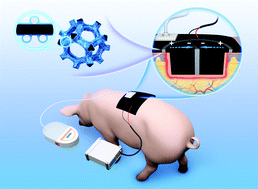Optimizing microenvironment by integrating negative pressure and exogenous electric fields via a flexible porous conductive dressing to accelerate wound healing†
Abstract
Wound healing is a complex and sequential biological process that involves multiple stages. Current treatments for nonhealing or chronic wounds are unsatisfactory as they exert a single effect on one specific activity. Herein, we constructed a silver nanowire (AgNW)-based, three-dimensional (3D), porous foam dressing that is flexible and conductive. This conductive foam dressing was composed of AgNWs modified with a stable hydrophobic coating and porous polyurethane (PU), providing a skeleton to support the 3D conductive networks. The AgNWs-PU foam dressing exhibited favorable biocompatibility, outstanding electrical properties, excellent bending-compression durability, and long-term stability under wet conditions, making it suitable for wound treatment. Via the conductive foam dressing, negative pressure and exogenous wound directional electric fields (EFs) could be integrated for simultaneous implementation, and the artificial jointly constructed microenvironment promoted wound healing in a system. This novel “all-in-one” device presented intrinsic multifunctionality, including the drainage of pus and necrotic tissue, mitigation of inflammation, promotion of cell proliferation, direction of keratinocyte migration, and induction of angiogenesis. An immunohistochemical assay and western blot analysis illustrated that the angiogenesis and cell proliferation pathways in the tissue were significantly activated when this novel therapy was adopted. More importantly, the practical performance of this “all-in-one” device was demonstrated by assessment of full-thickness defect wounds in model pigs. Comparing the percentage of residual wound area after administration of traditional treatment (25.82 ± 3.52%) and the novel treatment (3.07 ± 1.23%) demonstrated the promising applications of this novel treatment in clinical wound healing.



 Please wait while we load your content...
Please wait while we load your content...